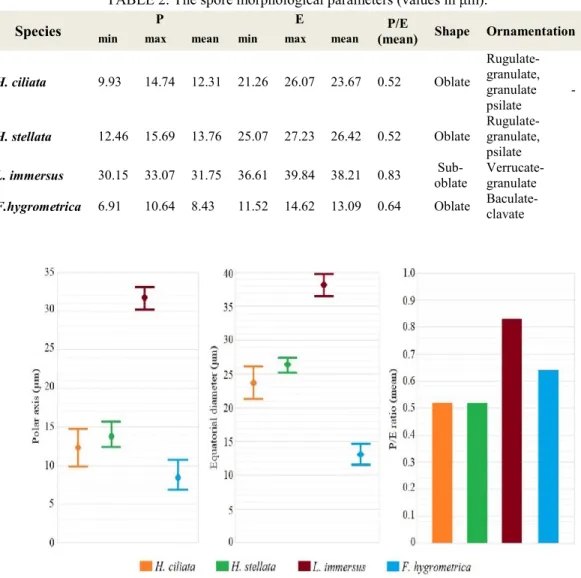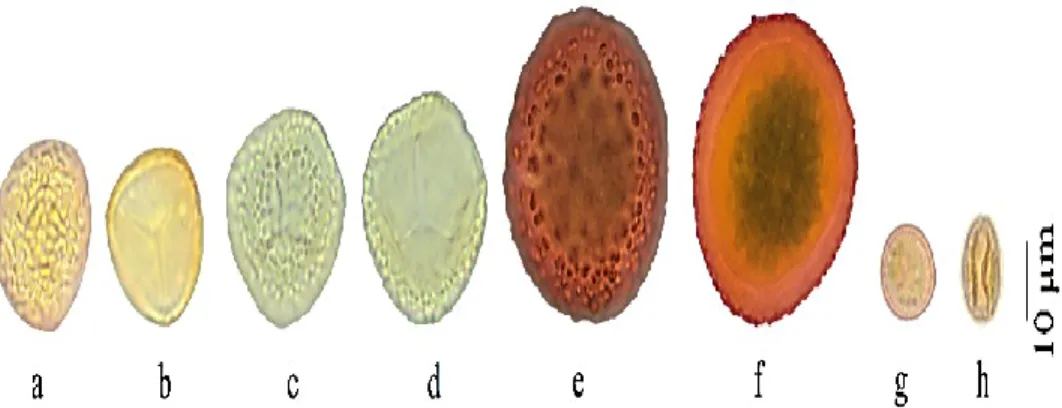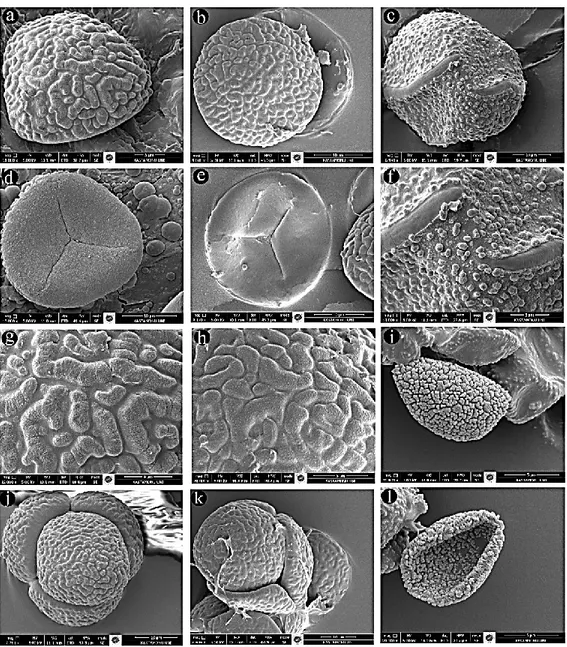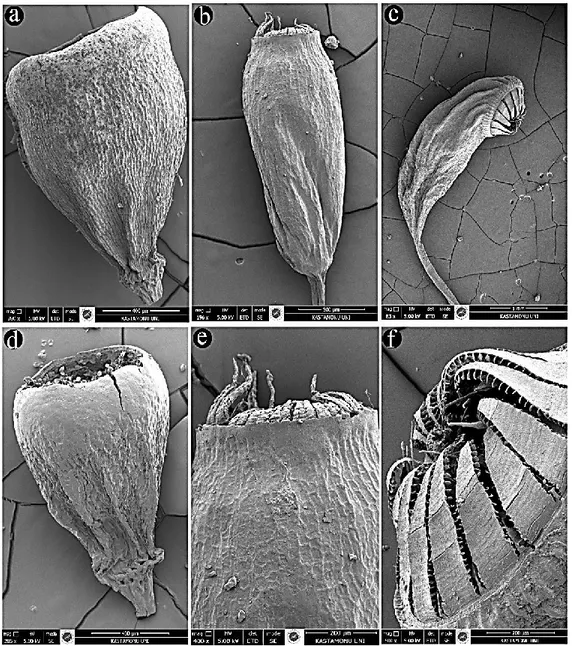DOI: 10.1501/commuc_0000000216 ISSN 1303-6025 E-ISSN 2651-3749
http://communications.science.ankara.edu.tr/index.php?series=C
Received by the editors: December 02, 2018; Accepted: December 07, 2018. Key word and phrases: Bryophyte Moss, SEM, spores morphology, capsule structure.
Submitted via II. Aerobiology and Palynology Symposium 07-10 October 2018 (APAS 2018)
© 2018 Ankara University Communications Faculty of Sciences University of Ankara Series C: Biology
SPORE MORPHOLOGY OF SOME TURKISH MOSS SPECIES
MERVE CAN GOZCU, TALIP CETER, GURAY UYAR
Abstract. In this study, spore morphology of Hedwigia ciliata (Hedw.) P.Beauv., H. stellata Hedenäs, Leucodon immersus Lindb. and Funaria hygrometrica Hedw. were examined by light microscopy (LM) and scanning electron microscopy (SEM). All species except L. immersus have small spores, the length of the polar axis (P) is between 8.43 µm and 31.75 µm, equatorial diameter (E) is between 13.09 µm and 38.21 µm. The smallest spores are seen in F. hygrometrica, while the largest spores are seen in L. immersus. The shapes of the spores are determined as oblate for H. ciliata, H. stellata, F. hygrometrica, and suboblate for L. immersus. Ornamentations are differing near leptoma and on distal pole. Rugulate-granulate, verrucate-granulate, baculate-granulate ornamentation types were observed on the distal pole. Granulate-psilate, psilate, loose baculate-clavate ornamentation types were observed near leptoma. In addition to spore morphology, capsule structures were also examined and were photographed with LM and SEM. As a result, the spore size, shapes and ornamentation types and the capsule structures show differences among these species and these differences can be used as a distinctive characters in the identifications of them.
1. Introduction
Bryophytes are generally small but form a striking part of the vegetation in cooler northern and southern latitudes and extremely humid climates of both temperate and tropical regions. This small but well-established group of plants is unique among other land plants in having a dominant gametophyte phase in their life cycle and a single unbranched sporophyte that depends on the dominant gametophyte plant. After that, the sporophyte produces a single terminal sporangium and spore mother cells are differentiated within it. The spore mother cells undergo meiosis, and each produces a tetrad of spores [1]. Dispersal of bryophytes occurs by spores, which are usually very small, commonly wind-dispersed, and by unspecialised asexual propagules originating from the gametophyte with a high potential for regeneration [2]. In addition, spores are a potential source of information concerning the evolutionary processes. Spore characteristics such as sizes, shapes
and morphology, are widely used in taxonomic analyses and in the descriptions of bryophytes [3]. Some recent papers have shown that the spore external morphology is useful to characterize moss taxa at the generic and specific levels [4-13]. However, the bryophyte spores in Turkey are not fully known. That’s why in our study, we have examined the spore morphology with the light microscope (LM) and the scanning electron microscope (SEM) of 4 Turkish moss taxa (Hedwigia ciliata (Hedw.) P.Beauv., H. stellata Hedenäs, Leucodon immersus Lindb. and Funaria hygrometrica Hedw.).
Hedwigia ciliata and H. stellata, which belong to Hedwigiacea family, usually grow on dry rocks [14]. H. ciliata is of almost cosmopolitan distribution. Against that, H. stellata occurs in North America, Central and Northern Europe. Both species are widely distributed in Turkey. The species have dull and hoary appearance with numerous immersed capsules. H. stellata is distinguished from H. ciliata by its mostly recurved hyaline leaf apices in the upper shoots when dry [15]. Leucodon immersus, which belongs to the Leucodontaceae family, is a Eurasian species and usually grows on dry and acidic tree trunks and rocks [14]. The species is located in Marmara, Black Sea, Central Anatolia and Mediterranean regions in Turkey [16]. L. immersus is characterized with immersed capsules [17].
Funaria hygrometrica, which belongs to the Funariaceae family, is a cosmopolitan species and widely distributed in Turkey [14,16]. The species is easily distinguished by its unique peristome teeth.
2. Material And Methods
The spore and capsule materials were obtained from the bryophyte herbarium of Ankara Hacı Bayram Veli University Polatlı Science and Arts Faculty. List of spores examined are given in the Table 1. The external surfaces of the spores were observed using light microscopy (LM) and scanning electron microscopy (SEM). The spores were prepared by the Wodehouse [18] method for LM photographs. Measurements of the diameters in the polar axis (P) and in the equatorial view (E) were taken in 20 randomly selected spores. The Simpson and Roe graphical test was used for graphical calculations [19]. The capsules were observed using stereo microscopy and scanning electron microscopy. The mouth diameter, length and width in 20 randomly selected capsules were measured. Olympus SZX7 model light microscope, BX47 model stereo microscope and SC 100 Model image
analysis system were used to photograph and measurements the spores and the capsules.
For scanning electron microscopy, the spores and capsules were directly placed onto stubs which have double-sided carbon band. The stubs were coated with gold-palladium alloy at voltage of 40 mV for 60 seconds in a vacuum evaporator and examined with Quanta Feg 250 scanning electron microscopy in Kastamonu University Central Research Laboratory.
The terminology for spore morphology was proposed by Erdtman [20], Boros and Járai-Komlódi [21], Blackmore and Barnes [22], Punt et al. [23] and Kapp et al. [24].
TABLE 1. The details of specimens and localities.
Species Localities
Hedwigia ciliata Sakarya (Pamukova); on rock, Pinus nigra J.F.Arnold, Quercus L. and Juniperus L. forest, 985 m alt., 40°33'16''N, 30°00'17''E, 12.05.2018. Hedwigia stellata Bursa (Gemlik); on rock, Fagus orientalis Lipsky and Carpinus betulus L. forest, 742 m alt., 40°32'20''N, 29°04'20''E, 11.05.2018. Leucodon
immersus
Kocaeli (Kartepe); on tree, Fagus orientalis Lipsky and Carpinus betulus L. forest, 1375 m alt., 40°38'48''N, 30°07'01''E, 12.05.2018.
Funaria hygrometrica
Sakarya (Akyazı); on soil, Abies nordmanniana subsp. equi-trojani (Asch. & Sint. ex Boiss.) Coode & Cullen and Pinus sylvestris L. forest, 1140 m alt., 40°33'21''N, 30°36'05''E, 12.05.2018.
3. Results
3.1. Hedwigia ciliata and H. stellata: Spores are small, sub-tetrahedral, oblate,
heteropolar, katalept and in tetrad form. The sclerine surface is ornamented by rugulate elements with granules ornamentations in the distal face and granulate-psilate elements in the proximal face. The length of the polar axis (P) of H. ciliata is average 12.31 µm, equatorial diameter (E) is average 23.67 µm in diameter, the ratio of polar axis to equatorial diameter is ~0.52. The length of the polar axis of H. stellata is average 13.76 µm, equatorial diameter (E) is average 26.42 µm in diameter, the ratio of polar axis to equatorial diameter is ~0.52 (Table 2, Figure 1). The rugulate elements of H. stellata (average 2.5 µm long and 1 µm wide) are shorter and thinner than H. ciliate (average 5.5 µm long and 1.5 µm wide). The aperture consists of trilete leptoma. Laesura arms are thin and distinct (Figure 2, 3). The capsules are obovoid, average 0.85 mm wide, 1.25 mm long, ~1.4 times as
long as wide in H. ciliata and average 0.7 mm wide, 1.25 mm long, ~1.7 times as long as wide in H. stellata. Peristome absent (Table 2, Figure 1-4).
TABLE 2. The spore morphological parameters (values in μm).
FIGURE 1. Graphical comparison of the length of polar axis (P), equatorial diameter (E) and P/E rotations (minimum, maximum and mean values).
Species min max P mean min max E mean (mean) P/E Shape Ornamentation
H. ciliata 9.93 14.74 12.31 21.26 26.07 23.67 0.52 Oblate Rugulate-granulate, granulate -psilate H. stellata 12.46 15.69 13.76 25.07 27.23 26.42 0.52 Oblate Rugulate-granulate, psilate
L. immersus 30.15 33.07 31.75 36.61 39.84 38.21 0.83 Sub-oblate Verrucate-granulate
FIGURE 2. LM spore microphotograph. a-b: H. ciliata; c-d: H. stellata; e-f: L. immersus; g-h: F. hygrometrica (a, c, e, g: distal view; b, d, f, h: proximal view).
3.2. Leucodon immersus: Spores are medium-sized, sub-oblate, heteropolar and
katalept. The sclerine surface is ornamented by verrucate-granulate elements. The verruca elements are irregular in size, between 0.4-1.1 µm long. The length of the polar axis is average 31.75 µm, equatorial diameter (E) is average 38.21 µm in diameter, the ratio of polar axis to equatorial diameter is ~0.83. Leptoma is narrow cracks form. There is no ornamentations on leptoma. The capsules are ellipsoidal to oblong, average 0.93 mm wide and 1.90 mm long, ~2.0 times as long as wide. Peristome present, teeth are lanceolate, papillose, average 170 µm long (Table 2, Figure 1-4).
3.3. Funaria hygrometrica: Spores are small, sub-oblate, heteropolar and katalept.
The sclerine surface is ornamented by baculate-clavate elements. The end of the bacula and clava is the dentate. The length of the elements is between 0.2-0.5 µm. The length of the polar axis is average 8.43 µm, equatorial diameter (E) is average 13.09 µm in diameter, the ratio of polar axis to equatorial diameter is ~0.64. The aperture consists of concave leptoma. The ornamentations weaken in the leptoma. The capsules are pyriform, asymmetric, furrowed, average 1.16 mm wide and 2.97 mm long, ~2.5 times as long as wide. Peristome present, teeth are papillose, sigmoid and trabeculate, average 540 µm long, endostome segments are lanceolate, papillose, average 380 µm long (Table 2, Figure 1-4).
4. Discussion
The spore morphology of Turkish Hedwigia ciliata, H. stellata, Leucodon immersus and Funaria hygrometrica studied by LM and SEM. Among them, the spores of H. ciliata and F. hygrometrica have previously been described [4, 25, 26]. The results presented here are in accordance with these studies. However, discrepancies that have not previously been referred to in the literature, specifically relating to surface ornamentation in H. stellata and L. immersus, were observed during the present study.
All species except Leucodon immersus have small spores, the length of the polar axis (P) is between 8.43 µm and 31.75 µm, equatorial diameter (E) is between 13.09 µm and 38.21 µm. The smallest spores are seen in Funaria hygrometrica, while the largest spores are seen in L. immersus. The shapes of the spores are determined as oblate for Hedwigia ciliata, H. stellata, F. hygrometrica, and suboblate for L. immersus. Tetrad spores were observed in H. ciliata and H. stellata.
All spores are katalept. Spore walls are thick on distal pole, tapers to proximal pole and forms leptoma. Leptoma is concave, trilete or irregular cracks forms. Ornamentations are differing near leptoma and on distal pole. Rugulate-granulate, verrucate-granulate, baculate-granulate ornamentation types were observed on the distal pole. Granulate-psilate, psilate, loose baculate-clavate ornamentation types were observed near leptoma. The ornamentations are diluted on the leptoma. The shapes and sizes of the capsules are different. Capsules of Hedwigia ciliata, H. stellata and Leucodon immersus are erect and symmetrical, while capsules of Funaria hygrometrica is inclined and asymmetrical. The smallest capsules are in H. ciliata, the largest capsules are in F. hygrometrica. L. immersus has lanceolate and F. hygrometrica has sigmoid, trabeculate peristome teeth, while Hedwigia ciliata and H. stellata have not peristome.
Consequently, the spore morphology and capsule structures in examined Hedwigia ciliata, H. stellata, Leucodon immersus and Funaria hygrometrica show distinguish characters which are important for taxonomic studies.
FIGURE 3. SEM spore photograph. a, d, g, j: H. ciliata; b, e, h, k: H. stellata; c, f: L.
immersus; i, l: F. hygrometrica (a, b, c, i: distal view; d, e, l: proximal view; f, g, h: spore
FIGURE 4. SEM capsule photograph a: H. ciliata; b, e: L. immersus; c, f: F. hygrometrica; d: H. stellata.
References
[1] W.B. Schofield, Introduction to Bryology. The Blackburn Press, (2001), Caldwell.
[2] J. Heinrichs, J. Hentschel, K. Feldberg, A. Bombosch and H. Schneider, Phylogenetic biogeography and taxonomy of disjunctly distributed bryophytes. Journal of Systematics and Evolution, 47(5), (2009) 497-508. [3] J.S. Carrión, M.J. Cano and J. Guerra, Spore morphology in the moss genus
Pterygoneurum Jur. (Pottiaceae). Nova Hedwigia, 61, (1995) 481-496. [4] R. Khoshravesh and S. Kazempour Osaloo, Spore morphology of certain
mosses of northern Tehran-Iran: taxonomical and ecological implications. Iran Journal Botany, 13(2), (2007) 150-159.
[5] I. Potoglu Erkara and F. Savaroglu, Spore morphology of some Brachytheciaceae Schimp. species (Bryophyta) from Turkey. Nordic Journal of Botany, 25, (2007) 194-198.
[6] F. Savaroglu, I. Potoglu Erkara, C. Baycu and M. Alkan, Spore morphology of some Bryaceae Schwägr. species (Bryophyta) from Turkey. International Journal of Natural and Engineering Sciences 1 (2), (2007) 49-54.
[7] F. Savaroglu and I. Potoglu Erkara, Observations of spore morphology of some Pottiaceae Schimp. species (Bryophyta) in Turkey. Plant Systematics and Evolution, 271, (2008) 93-99.
[8] N. Medina, B. Estebanez, F. Lara and V. Mazimpaka, On the presence of dimorphic spores in Orthotrichum affine (Bryopsida, Orthotrichaceae). Journal of Bryology, 31, (2009) 127-129.
[9] B. Ascı, T. Ceter , N. Pınar, H. Colgecen and B. Cetin, Spore morphology of some Turkish Tortula and Syntrichia species (Pottiaceae Schimp., Bryophyta. The Herb Journal of Systematic Botany, 17 (2), (2010) 165-180. [10] I. Caldeira, A. Luizi-Ponzo and V. Esteves, Palynology of selected species
of Fissidens (Hedw.). Plant Systematics and Evolution, 299, (2013) 187-195. [11] F. Savaroglu, Spore morphology of some Orthotrichaceae Arn. species
(Bryophyta) from Turkey. Bangladesh Journal of Botany, 44 (4), (2015) 499-506.
[12] T. Ceter and K. Canlı, Türkiyede yayılış gösteren bazı Grimmia (Grimmiaceae, Bryophyta) türlerin spor morfolojisinin incelenmesi. III. Aerobiyoloji, Palinoloji ve Alerjik Hastalıklarda Son Yenilikler Sempozyumu (APAS 2016), 5-7 Kasım 2016, Kastamonu/Türkiye, (2016).
[13] G.M.A. Lashin, Fine structures of some Bryoflora spores from Saudi Arabia. The Egyptian Journal of Experimental Biology (Botany), 7, (2011) 35-41.
[14] K. Dierben, Distribution, ecological amplitude and phytosociological characterization of European bryophytes. Bryophytorum Bibliotheca, Band 56, (2001) Stuttgart.
[15] A. Erdag, M. Kırmacı, and H. Kurscher, The Hedwigia ciliata (Hedw.) Ehr. ex P.Beauv. complex in Turkey, with a new record, H. ciliata var. leucophaea Bruch & Schimp. (Hedwigiaceae, Bryopsida). Turkish Journal of Botany, 27, (2003) 349-356.
[16] A. Erdag and H. Kurscher, Türkiye bitkileri listesi (Karayosunları). Ali Nihat Gokyigit Vakfı, Flora Araştırmaları Dernegi, (2017) İstanbul.
[17] M.S. Ignatov and V.Y. Czerdantseva, The families Cryphaeaceae, Leucodontaceae and Leptodontaceae (Musci) in Russia. Arctooa, 4, (1995) 65-104.
[18] R. Wodehouse, Pollen grains. Mc. Grew Hill, (1935) New York.
[19] A. Van der Pluym and M. Hideux, Application d’une mèthodologie quantitative á la palynologie d’Eryngium maritimum (Umbelliferae). Plant Systematics and Evolution, 127, (1977) 55-85.
[20] G. Erdtman, Pollen and spore morphology/plant taxonomy; Gymnospermae, Pteridophyta, Bryophyta. Almquist and Wiksell, (1957), Stockholm.
[21] A. Boros and M. Járai-Komlódi, An atlas of recent European bryophyte spore. Akademiai Kiado, (1975), Budapest.
[22] S. Blackmore and S. Barnes, Pollen and Spores. Patterns of Diversification. The Systematics Association. Special Vol. No. 44. Clarendon Press, (1991), Oxford.
[23] W. Punt, S. Blackmore, S. Nilsson and A. Le Thomas, Glossary of pollen and spore terminology, contributions series No:1. LPP foundation, (1994), Netherlands.
[24] R. Kapp, O. Davis and J. King, Pollen and spores, the American association of stratigraphic palynologists foundation. Texas A&M University, (2000), USA.
[25] A. Boros, M. Járai-Komlódi, Z. Töth and S. Nilson, An atlas of recent European bryophyte spores. Akademiai Kiado, (1993), Budapest.
[26] E.A. Ignatova, O.I. Kuznetsova, V.E. Fedosov and M.S. Ignatov, On the genus Hedwigia (Hedwigiaceae, Bryophyta) in Russia. Arctoa, 25, (2016) 241-277.
Current Address: MERVE CAN GOZCU: Ankara Hacı Bayram Veli University, Polatlı Faculty of Science and Arts, Department of Biology, Ankara, Turkey.
E-mail: mcgozcu@gmail.com
ORCID: https://orcid.org/0000-0001-7935-6314
Current Address: TALIP CETER: Kastamonu University, Faculty of Science and Arts, Department of Biology, Kastamonu, Turkey.
E-mail: talipceter@hotmail.com
ORCID: https://orcid.org/0000-0003-3626-1758
Current Address: GURAY UYAR: Ankara Hacı Bayram Veli University, Polatlı Faculty of Science and Arts, Department of Biology, Ankara, Turkey.
E-mail: gurayuyar@hotmail.com



